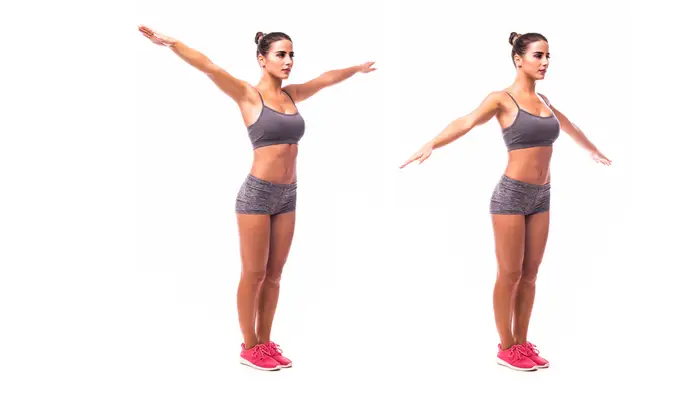Arm Stretches Before Workout: The Ultimate Guide for Injury Prevention and Performance Boost
Essential exercises involving lengthening and relaxation of the muscles in your arms, shoulders, forearms, and wrists are arm stretches. Any exercise program should include these stretches; particularly before a workout. Arm stretches mostly help to improve flexibility and mobility by preparing the muscles and joints for the upcoming physical activity.
Doing the right arm stretches before workout can help your muscles work better, reduce stress, and increase blood flow. These benefits make arm stretches an important part of warming up, helping your body get ready for strength training and sports.
The Importance of Stretching Before Exercise
Before activity, dynamic stretching—versed from static stretching—is the most efficient kind of stretching. Moving your muscles through their whole range of motion helps them to warm them up and boost circulation. Dynamic stretches help your body to increase flexibility, joint mobility, and coordination—all of which will help you perform better during the workout.
Targeting the muscles in your arms, shoulders, and wrists, arm stretches serve to release tension, prevent damage, and get your body ready for the rigors of physical exercise. Arm stretches are absolutely essential for maximizing your performance and reducing your chance of injury whether your workout is high-intensity cardio or weight lifting.

Why Arm Stretches Are Essential Before a Workout
Prepares Muscles for Activity
By increasing blood flow and hence enhancing range of motion, stretching before exercise helps your muscles get ready. This increases the supple and responsive nature of your arms and shoulders by helping to stimulate their muscle fibers, thereby enabling their needs of the workout. Especially while executing motions requiring a great degree of mobility, a good stretch practice can also improve your flexibility, therefore significantly affecting your performance.
Reduces the Risk of Injury
Always a worry is the possibility of injury, particularly in weightlifting or high-intensity exercise. Prevention of common injuries including muscle strains and joint sprains depends critically on arm stretches. Dynamic arm stretches, for instance, help to relax stiff muscles and get them ready for strength training, therefore lowering the risk of overuse problems or unexpected strains during exercise.
Stretching your arms also helps release tension in important places including the forearms and shoulders, which are often under great strain in exercises. Arm stretches help you reduce the typical among sports and gym-goers’ risks of tendonitis or shoulder impingement.
Improves Circulation and Flexibility
Arm stretches include among its most important effects increased circulation and flexibility. While eliminating metabolic waste products, the higher blood flow helps feed the muscles with oxygen and other nutrients. This improved circulation can help muscles heal following an exercise and help to lower post-workout pain.
Regular stretching also increases your general flexibility, thereby enabling more effective contraction and stretching of your muscles. This improved adaptability not only improves workout performance but also helps to avoid injuries.
Optimizes Performance
Good arm stretches enable your muscles to perform as they should throughout physical exercise. Particularly helpful for activities requiring accuracy and control, stretching helps the muscles in your wrists, shoulders, and arms coordinate and function. During overhead lifts or push-ups, for instance, a well-stretched shoulder can improve form and technique, thereby optimizing strength output.
Arm stretches let athletes have faster reflexes and more fluid range of motion. Arm stretches help your arms be ready for quick motions and effective power generation whether your game is tennis, swimming, or basketball.
Effective Arm Stretches to Do Before Your Workout
Including a range of stretches targeting various areas of the arms can help to maximize the advantages of arm stretches. These are some of the most powerful arm stretches you should perform prior to your workout:
1- Arm Circles
- How to Perform: Out to the sides at shoulder height, extend your arms. Starting small circles with your arms, progressively widen the circles with your arms. Move both forwards and backwards in this way.
- Target Areas: Shoulders, upper arms, and deltoids.
- Key Benefits: Excellent for warm-up the shoulder joints and enhancing shoulder mobility are arm circles. This stretch also works the deltoids and upper arms, thereby getting them ready for lifting activities.
- Expert Tips: Maintaining straight and under control arms will help you throughout the motion. Steer clear of any jerkes to keep control and lower your strain risk.

2-Triceps Stretch
- How to Perform: Bending the elbow, reach one arm above and bring the hand down near the other shoulder blade. Press the elbow softly with the other hand to stretch more.
- Target Areas: Triceps and upper arms.
- Key Benefits: Targeting the triceps, this stretch helps push-ups and bench presses—two movements heavily dependent on them. Before a workout, triceps stretching helps avoid elbow pain and improves upper-body performance.
- Expert Tips: Don’t drive the elbow far behind your head. Instead, concentrate on a light stretch and maintain neck relaxation.

3-Wrist Flexor Stretch
- How to Perform: In front of you, extend your arm palm facing up. To stretch the wrist flexors, gradually draw back the fingers toward your body with the other hand.
- Target Areas: Forearms and wrists.
- Key Benefits: If you do weight-bearing activities like push-ups or lifts, this stretch is particularly important for wrist mobility. It also lessens wrist tension and gets the muscles ready for gripping actions.
- Expert Tips: Stretching carefully and slowly can help you to avoid pushing the wrist into an unpleasant posture.

4-Cross-Body Shoulder Stretch
- How to Perform: Reach one arm shoulder height across your body. To deepen the stretch, hold the upper arm with the other hand and draw it toward your chest.
- Target Areas: Shoulders, rotator cuffs, and upper back.
- Key Benefits: Excellent for relieving tension in the upper back and enhancing shoulder flexibility is this stretch. It helps mainly to increase shoulder mobility required for overhead motions.
- Expert Tips: Straight your back and try not to round your shoulders. Emphasize keeping the stretch modest and within a comfortable range of motion.

5-Overhead Reach
- How to Perform: Lengthen your body and arms by carefully stretching to either side from both arms aloft.
- Target Areas: Shoulders, last, and upper back.
- Key Benefits: This elongates the arm muscles and opens the chest, therefore improving shoulder and upper back flexibility. It also works the last, which are essential for pull-downs.
- Expert Tips: Stretching will help you engage your core muscles, thereby avoiding any lower back pain. Steer clear of overstretching and maintain regulated motion.

6-Bicep Stretch
- How to Perform: To stretch the biceps, extend your arms behind you, palms face up, then softly press your chest upward.
- Target Areas: Biceps and forearms.
- Key Benefits: Targeting the biceps, this stretch gets them ready for push-ups and bicep curls. It also eases shoulder and arm strain.
- Expert Tips: Ensure that your shoulders stay down and relaxed to prevent neck strain.

When Should You Do Arm Stretches?
Best Time to Stretch
Your warm-up should consist of arm stretches, more especially dynamic stretches. These stretches help your muscles get ready for the motions and activities you intend to do, hence they should be done before your training. Unlike static stretching, dynamic stretching moves, hence it is perfect for warming muscles and joints.
Conversely, as they aid in muscle relaxation and flexibility following physical exertion, static stretches are better suited for post-workout programs.
Frequency and Duration
Aim to stretch every muscle group for at least thirty seconds before your activity to fully benefit from arm stretches. To guarantee best flexibility and movement, repeat each stretch two to three times each arm. Your workout will determine the frequency of arm stretching; still, adding stretches before every exercise will assist keep and increase your flexibility and prevent injuries.
Common Mistakes to Avoid with Arm Stretches
- Overstretching: Muscle tension and damage can result from overstretching. You must understand your limits and stretch inside a comfortable range of motion. Stop right away and back off from the stretch if you experience pain.
- Static Stretching Before Exercise: Before an exercise, one should not do static stretches—that is, stretches held for a long duration. Static stretching can cause muscle tightness and lower strength during activity. To increase flexibility, save static stretches until following your exercise.
- Incorrect Form: Bad form runs against the advantages of arm stretches and raises injury risk. Always give correct posture and controlled motions first priority. Steer clear of jerky motions since they strains ligaments and muscles.
- Not Warming Up First: Before you stretch, your body has to be warmed. Light aerobics, such as jumping jacks or jogging, raises blood flow and heart rate, therefore priming your muscles for stretching.
How to Incorporate Arm Stretches into Your Routine
Creating a Warm-Up Routine
Include your arm stretches within a 5-minute dynamic warm-up to maximize their benefits. To get the blood flowing, start with light cardio—jogging or jumping jacks—then the arm stretches discussed here. Targeting all main muscle groups, including your arms, legs, and core, a full warm-up should
Integrating Arm Stretches into Other Fitness Goals
From sports to strength training, arm stretches can augment many kinds of exercises. Arm stretches will help you perform better and lower your risk of injury whether your main goals are upper body strength or flexibility in yoga.
Conclusion
An important first step in injury prevention and performance improvement in your warm-up is including arm stretches. These stretches help your muscles be ready for the demands of your exercise in addition to increasing circulation and flexibility. Stretching your wrists, shoulders, and arms will help you to maximize your exercise effectiveness and lower your chance of injury.
